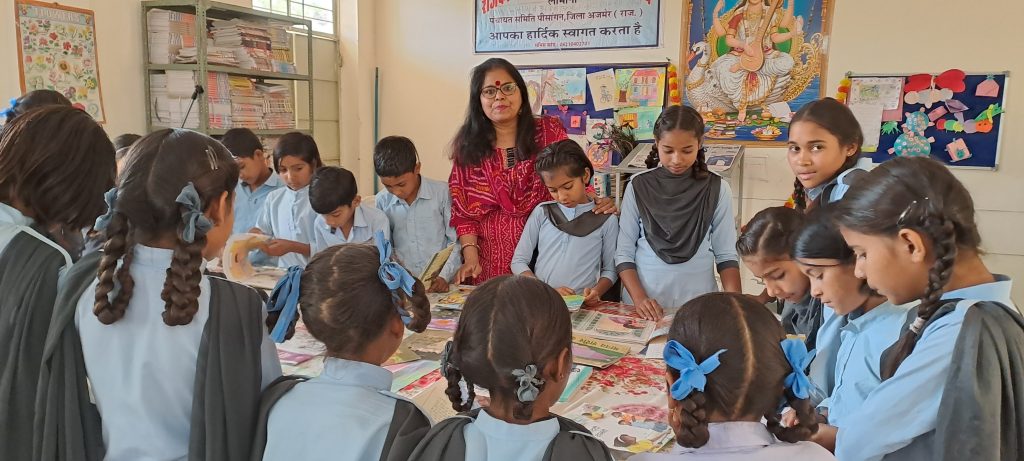
A new chapter begins for Rajasthan school libraries
Once abandoned as storerooms for old and broken stuff, school libraries are buzzing again—thanks to the Rajasthan Library Promotion Project that aims to develop the habit of reading among children.

Once abandoned as storerooms for old and broken stuff, school libraries are buzzing again—thanks to the Rajasthan Library Promotion Project that aims to develop the habit of reading among children.
Birju loves khichdi, but keeps forgetting the word for his favourite food. Memory isn’t the strong suit of seven-year-old Mohan either. But when he plays protagonist Birju for the school play ‘Khichdi…Ek Lok Katha’, the Class II student in Ajmer of Rajasthan remembers and delivers his lines with expression, feeling and fluency.
The rest of his class claps at the end of the performance in the school’s decked out library. Mohan puffs up his chest in joy. Others volunteer for the next play.
Shilpi Chauhan, the librarian at Government Higher Senior Secondary School, in Saradana, Ajmer, is delighted too.

Her students picked up the script from just two readings she gave in their “library period”—a class introduced in the state’s public school routine to encourage children to read.
Also Read | Asia’s ‘biggest’ underground library in Rajasthan has no readers
School libraries are buzzing again in the state, drawing students to books like bears to the honey pot. Gone are the days when, according to the Unified District Information System for Education 2020-21 report, libraries in around 70 percent of schools were turned into storerooms with a few book-filled cupboards gathering dust.
The change came through the Rajasthan Library Promotion Project (RLPP). Based on a successful pilot project, the state signed an agreement with the Centre for Micro-Finance and the Parag Initiative of Tata Trusts in November 2019 to make 3,334 libraries up and running in each of the 33 districts.
Anchored by state resource groups (SRG), the primary job involved bringing librarians back to where they belong. The 2020-21 report says only 11 percent of schools had trained librarians and the remaining either had library in-charges or the positions were never filled.
When Brijesh Sharma joined Government Higher Senior Secondary School at Tasol village in Rajsamand five years ago, he was asked if he could teach maths and science. The librarian became a teacher by default.
The library room was the most neglected, either used as a dump for old things or as an examination hall.
“I found the books untouched,” Sharma said.
Once the project took off, school libraries woke up from sleep mode. They were renovated, remodelled, painted and decorated with illustrations. They became lively spaces for story times and other age-specific activities like games and plays tailored to expose children to books.

Teachers were trained too and library periods were introduced in nearly 51 percent schools in 2022. A 12-week children’s library course developed by Parag coached SRG members. The SRGs were assigned as master trainers, said Dr Vijay Kumar, head of the project in CmF.
All of a sudden, Chauhan’s job as a librarian has become fulfilling after 14 years of working in a school.
“Primary school students have two library periods a week. I read them stories from picture books,” she said.
Also Read | Brakes on boredom: Karnataka’s bus stop libraries
Chauhan also quizzes the students about the story to help them develop a deeper understanding of the context, which helps them connect what they have learned to other books and activities.
“Also, five books are issued to the students,” she said, adding that children were earlier not allowed to take home library books in case they lose or damage them.
“Now grandparents are reading to children books from the library,” said Malika Srivastav, executive director of CmF.
Students are being trained to take ownership of libraries, where they are encouraged to fix torn or damaged books. Students do it themselves, said Sharma, who has catalogued all the books in his library and organises book exhibitions twice a year.

During the pandemic, Sharma made audio and video clips of books and shared them on WhatsApp, but many children had no access to the internet. When restrictions eased, he filled a bag with books and stacked them under a tree in the village temple. Students took them home, read and returned them the following week.
A project review found at least 26 percent of schools had a library plan in 2022 as opposed to 8 percent in 2020, said Rahul Mukhopadhyay, one of the reviewers.
Extended school closures due to the pandemic took a toll on children’s learning abilities, long a precursor for dropping out of school.
“The training of teachers was most important. They could spread the culture of reading,” Mukhopadhyay said.
Before the library revival, many kids read haltingly. Others tripped over tricky words. Many didn’t read at all. The students now show vastly different levels of skill and confidence.
Also Read | An educator and his rural school with a difference
“My daughter stayed away from books. But now she reads books voraciously. She has become quite articulate too, telling me stories every other day,” said Krishna Kumar of Tasol.
The lead images at the top shows schoolchildren engrossed in reading story books in their newly refurbished library (Photo by Rakhee Roytalukdar)
Rakhee Roytalukdar is a journalist based in Jaipur, Rajasthan.